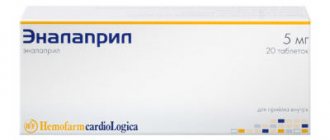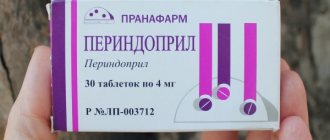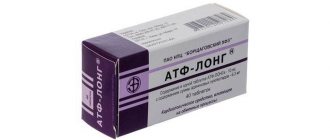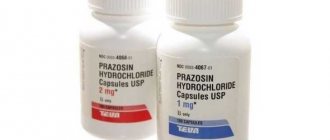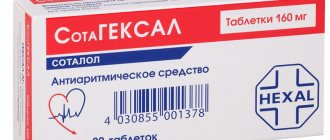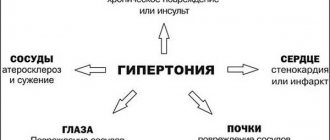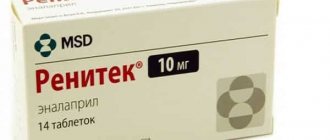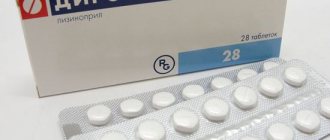"Nifedipine" is intended to stop and prevent attacks of angina pectoris in coronary heart disease (CHD) and to reduce alarming blood pressure (BP) for any reason for its excessive increase. Nifedipine makes it difficult for calcium ions to enter through the membranes of myocardial muscle cells and blood vessels. Reducing the calcium concentration in myocytes produces a relaxing and vasodilating effect. As a result, blood pressure and the resistance of the vascular system to blood flow decrease, and the load on the heart decreases accordingly.
Dosage forms
The active ingredient of the drug of the same name is nifedipine.
Fast-acting tablets (dragées) (rapid form), containing 10 mg of nifedipine, are used to suppress a hypertensive crisis or an episode of angina pectoris. A tablet (10 mg), preferably chewed, is dissolved under the tongue. With sublingual (oral) absorption, patients should lie down for half an hour to an hour, since the pressure-lowering effect may be too sharp and cause lightheadedness when standing up and moving. If the effect is insufficient, you can repeat taking the tablet after an hour. We remind you that the optimal rate of blood pressure reduction is no more than 20 mm Hg. Art. at one o'clock. After the attack has stopped, it may be advisable to take maintenance medication through the stomach (enterally).
Rapidly absorbed into the bloodstream and has a selective effect on calcium channels
Long-acting/delayed-release tablets "Nifedipine Retard" 20 mg with delayed release of the drug substance are used for long-term, corrective blood pressure within acceptable limits of therapy. They are drunk after meals, without crushing, 1-2 times a day. In retard form, nifedipine is in an inactive matrix, released from it little by little and gradually.
“Nifedipine” has a lot of analogues (commercial names): “Adalat”, “Anifed”; "Apo-Nifed"; "Vero-nifedipine"; "Hypernal"; "Depin-E"; "Zenusin"; "Calcigard"; "Cordafen"; "Cordaflex"; "Kordipin", "Corinfar"; "Myogard"; "Nicardia"; "Nifadil"; "Nifebene"; "Nifehexal"; "Nifedex"; "Nifedicap"; "Nifedicor"; "Nifedipat"; "Nifecard"; "Nifelat"; "Nifesan"; "Nificard"; "Novo-Nifedin"; "Osmo-Adalat"; "Ronian" "Sanfidipin"; "Sponif"; "Fenamon"; "Phenigidine"; "Flekor-N"; "Ecodipin". These are all nifedipine preparations with fast or delayed action.
Pharmacological properties
The drug Nifedipine, from which these tablets and injections help cope with high blood pressure, is a selective blocker of “slow” calcium channels, a derivative of 1,4-dihydropyridine. It has a vasodilating, antianginal and antihypertensive effect.
Reduces the flow of calcium ions into cardiomyocytes and smooth muscle cells of the coronary and peripheral arteries; in high doses suppresses the release of calcium ions from intracellular stores. Reduces the number of functioning channels without affecting the time of their activation, inactivation and recovery.
It uncouples the processes of excitation and contraction in the myocardium, mediated by tropomyosin and troponin, and in vascular smooth muscles, mediated by calmodulin. In therapeutic doses, it normalizes the transmembrane current of calcium ions, which is disturbed in a number of pathological conditions, primarily in arterial hypertension.
Does not affect the tone of the veins. The drug Nifedipine, the instructions for use indicate this, increases coronary blood flow, improves blood supply to ischemic areas of the myocardium without developing the “steal” phenomenon, and activates the functioning of collaterals. By dilating the peripheral arteries, it reduces the total peripheral vascular resistance, myocardial tone, afterload, myocardial oxygen demand and increases the duration of diastolic relaxation of the left ventricle.
It has virtually no effect on the sinoatrial and atrioventricular nodes and does not have antiarrhythmic activity. Increases renal blood flow, causes moderate natriuresis. The negative chrono-, dromo- and inotropic effects are overlapped by reflex activation of the sympathoadrenal system and an increase in heart rate in response to peripheral vasodilation. The onset of the effect is 20 minutes, the duration of the effect is 12-24 hours.
Disadvantages of the drug
Nifedipine can significantly reduce the force of heart contractions. In recent years, information has spread about the dangers of taking a rapid form of medication at high blood pressure levels, due to an increased risk of developing myocardial infarction. The question remains open about the justification of the systematic use of a fast-acting form in patients with coronary artery disease - there is evidence of an increased risk of deaths.
The drug Nifedipine can be taken only if the patient has no contraindications to its use
Nifedipine can produce a number of undesirable side effects:
- From the side of blood vessels and heart:
- excessive vasodilation (a drop in blood pressure below the physiological norm, rapid heartbeat, hot flashes, lightheadedness);
- increased symptoms of insufficient ability of the heart to pump blood, the appearance or intensification of peripheral swelling (ankles, legs, abdomen);
- triggering pathological rhythms of heart contractions, sometimes provoking an episode of angina pectoris; a few cases of myocardial infarction have been recorded.
- From the gastrointestinal tract:
- nausea, heartburn, diarrhea or constipation;
- disturbances in the normal functioning of the liver (manifested in increased transaminase activity, excessive concentration of bilirubin in the blood, subjectively - a feeling of intoxication, weakness, yellowish coloration of the mucous membranes);
- swelling of the gums and bleeding from them, as with stomatitis or periodontal disease (rare);
- From the nervous system:
- headache;
- lethargy, excessive need for sleep;
- disorders of the Parkinson's disease type - sensory disturbances, involuntary trembling of the hands, shuffling of the feet when walking, difficulty swallowing, poor facial expressions (with long-term use of significant doses); deterioration of cognitive abilities (with systematic use by elderly patients);
- depression, anxiety.
If the contraindications of the drug are not taken into account, taking the medication can cause serious consequences for the body.
- From the hematopoietic system (with a long course):
- anemia; decrease in platelet count,
- thrombocytopenic purpura
- decrease in the number of leukocytes.
- Allergic manifestations:
- urticaria, measles-like rash;
- peeling and inflammation of the skin, photodermatosis;
- autoimmune inflammation of the liver (extremely rare).
- On the part of the kidneys - an increase in the excretion of water and sodium: with prolonged use of large doses, a decrease in the excretory function of the kidneys is possible.
- From the joints and muscles:
- inflammation of the joints or intermittent pain in the joints without an inflammatory process;
- swelling of the joints;
- muscle soreness and cramps.
Redness of the face and upper torso is common
- Other:
- visual impairment (including transient blindness at peak drug concentrations in the blood), very rare;
- gynecomastia (enlarged mammary glands), galactorrhea (abnormal discharge of milk or colostrum from the nipples, including men), regressing after discontinuation of the medication;
- increased blood glucose levels;
- pulmonary edema, bronchospasm;
- excess weight gain;
- erectile dysfunction, decreased libido.
Indications for use:
- IHD accompanied by angina pectoris; suppression and prevention of episodes of angina pectoris;
- angina pectoris in the post-infarction period (except for the first 8 days);
- a sharp and significant increase in blood pressure above physiologically justified indicators (rapid form);
- chronic hypertension (retard forms);
- spasmodic contractions of cerebral vessels, causing cognitive or physiological pathological symptoms, in the absence of overt ischemic or hemorrhagic stroke;
- spasmodic narrowing of the vessels of the retina and labyrinth of the ear;
- Raynaud's disease (spasmodic narrowing of the peripheral vessels of the extremities).
The drug Nifedipine belongs to the drugs used in medical practice for hypertension and other pathologies of the heart and blood vessels.
Contraindications:
- low blood pressure (systolic below 90 mm Hg), including signaling collapse or cardiogenic shock;
- abnormal narrowing of the aortic mouth;
- uncompensated heart failure;
- the first 8 days of the post-infarction period;
- weakened functioning of the sinus node - the driver of the heart rhythm;
- blockade of the atrioventricular node 2 and 3 degrees;
- ventricular tachycardia with extended QRS interval;
- ventricular pre-excitation syndrome (LGL);
- syndrome of premature excitation of the ventricles with the congenital presence of an additional conduction bundle of Kent (WPW syndrome);
- porphyria;
- individual intolerance to nifedipine or additional substances;
- pregnancy and lactation.
Possible side effects
The use of Nifedipine in tablet form may cause side effects such as:
- leukopenia;
thrombocytopenia;
- increased daily diuresis;
- gynecomastia;
- kidney dysfunction;
- headaches;
- sleep disorders;
- tremors of the limbs;
- muscle pain (with prolonged use);
- visual impairment.
Long-term use of the drug can also have a negative impact on the functioning of the cardiovascular system. Thus, the drug can cause hypotension, asystole, bradycardia or tachycardia, and angina. Sometimes side effects from the gastrointestinal tract may be alarming: nausea, diarrhea, heartburn attacks.
"Nifedipine" for blood pressure during pregnancy
According to the instructions for the drug, it should not be taken during pregnancy. There are no reliable studies on the safety of the active substance, nifedipine, for a pregnant child. In experiments on animals, an increase in the frequency of congenital deformities and pathologies or intrauterine death of embryos was recorded.
It is prohibited to drink Nifedipine in the first weeks after conception.
However, according to specialists from the Russian National Research Medical University, there is a correlation between the use of Nifedipine by women in the first weeks (when they did not yet know that conception had occurred) or in the second half of pregnancy and the frequency of missed pregnancies, miscarriages or congenital pathologies in no children found.
Doctors do not have a consensus on the safety of using therapeutic doses of Nifedipine during pregnancy.
And yet, the drug is sometimes prescribed, but mainly after the 20th week, when the baby is mostly formed, and only for justified indications, such as:
- dangerously high blood pressure that is unresponsive to safer medications;
- hypertonicity;
- attacks of angina.
Nifedipine passes into mother's milk; its effect and the amount consumed by the child are not predictable. Therefore, you should avoid taking it during breastfeeding or stop breastfeeding your baby.
How to take Nifedipine for high blood pressure?
The approximate dose for a hypertensive crisis is 10 mg of rapid form (1 tablet) under the tongue, preferably in a chewed consistency. The dose can be added in the same amount no earlier than an hour after the initial use. It also stops an attack of angina. The maximum permissible amount of nifedipine (substance) per day is 120 mg.
Nifedipine tablets, placed unchewed under the tongue, dissolve within a few minutes
Standard, corrective blood pressure therapy with rapid forms involves a dosage of 10 mg of nifedipine 3 times a day (for high blood pressure, chronic angina).
Retard forms (slow release of the drug) are applicable only for maintenance treatment of chronic arterial hypertension or angina pectoris. The standard dosage is 20 mg 2 times a day (every 12 hours).
The duration of the appointment is determined by the doctor. If the Nifedipine course is abruptly stopped, a withdrawal syndrome with narrowing of blood vessels and a jump in blood pressure is likely. The long course is completed by gradually reducing the dose.
In case of an overdose of the drug, symptoms from the heart and blood vessels appear: headaches, blood pressure levels falling below normal, slowing and weakening of the pulse. The pulse may not be palpable in the arteries of the arms. Collapse with loss of consciousness, depression of sinus node function, and deterioration of atrioventricular conduction are possible.
In case of overdose, you need to rinse the stomach (if a little time has passed), take activated charcoal (1 tablet for every 10 kg of the patient’s weight). As an antagonist, a solution of calcium chloride or calcium gluconate is administered intravenously. Insulin production may be inhibited; in this case, drug correction of blood sugar levels is necessary.
Indications and contraindications
At what pressure can this pharmaceutical product be used? Nifedipine tablets are intended to reduce high blood pressure in any degree of hypertension, as well as to relieve hypertensive crises.
Pills
The tablet form of the drug is prescribed to patients only if there are strict indications, which include:
- vasospastic angina;
arterial hypertension (as part of complex therapy);
- congestive cardiopulmonary failure;
- heart failure;
- hypertrophic cardiomyopathy;
- pulmonary hypertension;
- disorders of blood circulation in the brain;
- bronchospasms;
- obstruction of blood vessels.
In addition, it is advisable to use the drug for ischemic heart disease and atherosclerotic processes in peripheral arteries.
The tablet form should absolutely not be used by patients with the following diseases:
- tachycardia;
- cardiogenic shock;
- collapse;
- heart failure in the decompensation phase.
The medicine should not be used to treat persons under 18 years of age, hypotensive patients, and patients with idiopathic hypertrophic subaortic stenosis.
Nifedipine is prescribed with extreme caution to diabetics, pregnant women, patients with CHF, malignant arterial hypertension and severe renal impairment. Under the careful supervision of a physician, treatment with this medication is carried out in patients undergoing hemodialysis sessions.
Ointment
Nifedipine gel emulsion is used to get rid of hemorrhoids accompanied by bleeding, anal fissures, prolapse of pathological nodes or their compression. In addition, the medicine has proven itself in the fight against perianal dermatitis.
Manufacturers do not provide information about contraindications to the use of ointment. The medication can be used during pregnancy.
